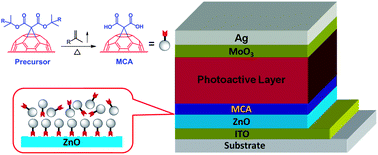Thermo-cleavable fullerene materials as buffer layers for efficient polymer solar cells†
Abstract
A new class of thermo-cleavable

* Corresponding authors
a
National Center for Nanoscience and Technology, Beijing 100190, China
E-mail:
OPV.CHINA@yahoo.com, xiaoz@nanoctr.cn
b University of Chinese Academy of Sciences, Beijing 100049, China
c Bruker (Beijing) Scientific Technology Co., Ltd., Beijing 100081, China
A new class of thermo-cleavable

 Please wait while we load your content...
Something went wrong. Try again?
Please wait while we load your content...
Something went wrong. Try again?
S. Chen, X. Du, G. Ye, J. Cao, H. Sun, Z. Xiao and L. Ding, J. Mater. Chem. A, 2013, 1, 11170 DOI: 10.1039/C3TA11811H
To request permission to reproduce material from this article, please go to the Copyright Clearance Center request page.
If you are an author contributing to an RSC publication, you do not need to request permission provided correct acknowledgement is given.
If you are the author of this article, you do not need to request permission to reproduce figures and diagrams provided correct acknowledgement is given. If you want to reproduce the whole article in a third-party publication (excluding your thesis/dissertation for which permission is not required) please go to the Copyright Clearance Center request page.
Read more about how to correctly acknowledge RSC content.
 Fetching data from CrossRef.
Fetching data from CrossRef.
This may take some time to load.
Loading related content
